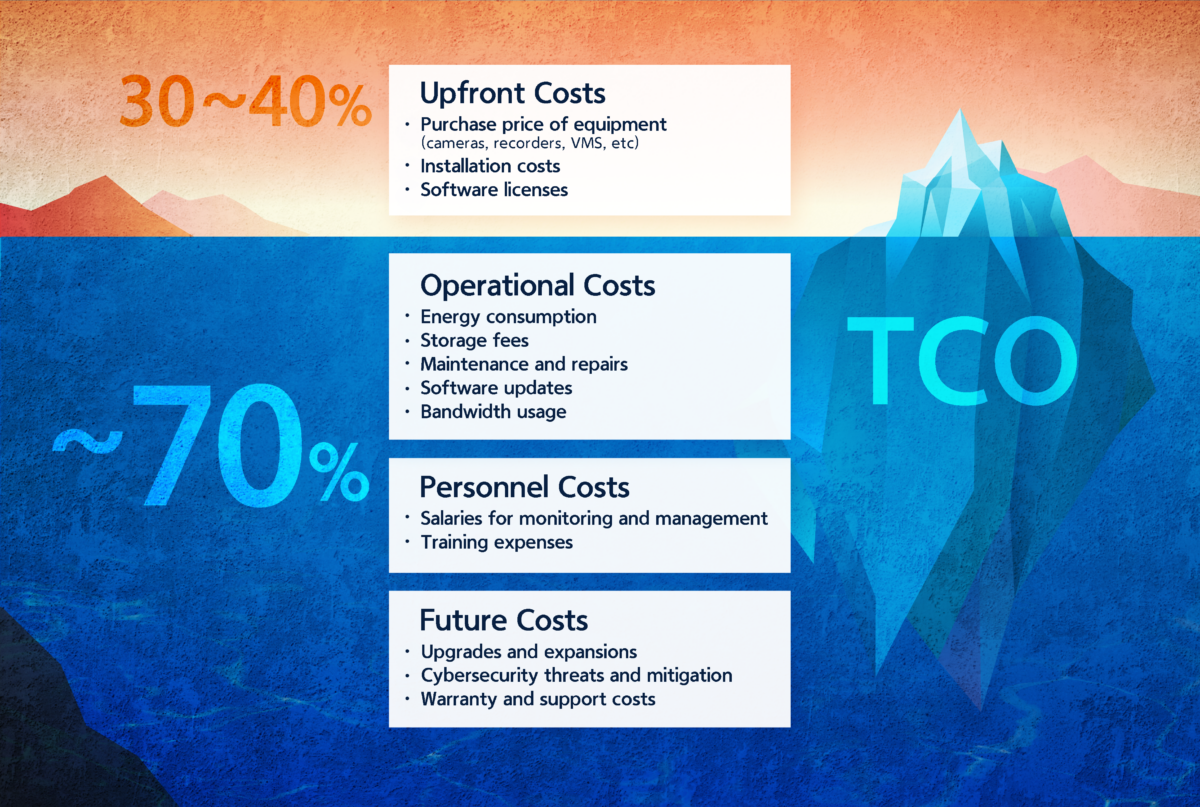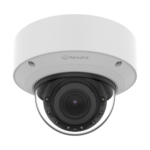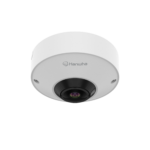2024.08.27
The True Value of TCO: A Guide for Security Professionals
If your role involves purchasing equipment, you are certainly familiar with the term – TCO (Total Cost of Ownership). Calculating TCO involves accurately tallying up all costs related to the full equipment lifecycle – owning, operating, and decommissioning your equipment.
For security professionals, understanding your TCO is crucial for aligning equipment choices with immediate and long-term business goals and operating budgets.
Below, we have highlighted key factors in TCO calculation, surprising statistics, things that are often overlooked, and common questions our Hanwha Vision team members worldwide encounter when it comes to TCO evaluations and making smart decisions.
Upfront Costs (Purchase, Installation, & License Agreements)
Your TCO analysis all starts here, with the initial purchase and installation costs for your equipment – whether its security cameras, recorders, video management software (VMS), cabling, and/or network devices.
It’s tempting to focus solely on the initial price tag, similar to choosing a car based on its sticker price. However, like owning a vehicle, the true cost of security equipment goes beyond the initial purchase. In fact, the initial price typically accounts for only 30-40% of the TCO.

To make informed decisions about your security investment, start by defining your specific needs and budget. Consider factors such as facility size, potential threats, and desired features. Conducting a thorough security audit can help identify vulnerabilities and determine the ideal devices and best camera placements for your commercial security camera system.
Once you have a clear understanding of your requirements, advanced tools like the Hanwha Vision Plugin for Autodesk Revit can significantly enhance your planning process. By virtually placing cameras in a building’s digital twin, security professionals can optimize camera placement, prevent costly mistakes, and achieve maximum coverage with minimal hardware.
For example, security planners can use the plugin to design a video surveillance system for a retail store and pinpoint optimal camera placements. You may be astonished at the potential to significantly decrease the quantity and expense of cameras within your retail store by virtually deploying technologies such as multi-sensor cameras.
Beyond hardware, software licensing and renewal costs should be carefully considered. When evaluating cameras with built-in video analytics, inquire about licensing fees. Not all video analytics accurately differentiate between humans, animals, and vehicles, leading to frustrating false alarms and increased costs. To future-proof your system, consider cameras with edge-based deep learning AI analytics.
Hanwha Vision offers many cameras with license-free AI data analytics, potentially saving you time and money.
Operational Costs
This includes both direct costs like server and infrastructure expenses, and indirect costs such as maintenance, software updates, and any ongoing long-term support. Additionally, unforeseen expenditures related to troubleshooting and new feature implementation can significantly impact overall costs.
To mitigate these challenges and streamline operations, Hanwha Vision offers Wisenet Device Manager and HealthPro. These solutions simplify device management and monitoring, allowing for efficient troubleshooting and proactive maintenance.
By automating routine tasks, providing real-time system insights, and optimizing device performance, these tools help reduce operational costs and improve overall system efficiency.”

Recurring operational costs also include monthly energy consumption for powering cameras and servers, storage fees (particularly for cloud-based systems), and bandwidth usage.
We often hear from companies that switch to Hanwha Vision solutions after becoming dissatisfied with their previous systems, expressing surprise at the operational costs and bandwidth demands of their former equipment.
Hanwha Vision offers several valuable solutions to help companies address bandwidth concerns and ensure cost consistency.
Our cutting-edge video-compression technology, WiseStreamIII, effectively maintains high video quality while significantly reducing data sizes. Users also value how WiseStreamIII can process more high-quality footage without the need for additional network and storage devices, providing substantial CapEx and bottom-line savings.
WiseStreamIII effectively maintains high video quality while significantly reducing data sizes.
Our Wisenet Toolbox PLUS can also help companies better understand bandwidth usage.
This all-in-one platform includes a Product Selector to assist in choosing the optimal cameras and recorders for your specific environment, a Field of View (FoV) Calculator to visualize camera coverage, and a Bandwidth Calculator to estimate network bandwidth based on user-defined camera settings.
By inputting various camera configurations, the Bandwidth Calculator determines the total bandwidth and storage needs for your Network Video Recorder (NVR).
What other ways can we reduce operational costs?
To explore additional cost-saving opportunities, consider the following:
- Do your cameras have built-in IR illumination? High-quality 24/7 imaging requires this to avoid costly supplementary lighting.
- Is your system compatible with leading VMS platforms? This flexibility is crucial for future expansion and cost-efficiency. Consider independent VMS suppliers offering ‘open platform’ software or camera manufacturers with their own VMS.
- What are the energy costs of your system components? IP network cameras featuring low power consumption Power over Ethernet (PoE) can significantly reduce power and installation expenses.
- Can cameras be remotely configured? Some cameras are equipped with motorized PTRZ function, allowing installation engineers to remotely pan, tilt, rotate, and zoom lens positions to set the FoV. This eliminates the need for costly on-site visits.
- How long is the installation time for the specified cameras, video recorders, or other devices? Manufacturers offering preinstalled VMS on servers and pre-uploaded video analytics in cameras can significantly reduce time and costs.
Personnel Costs (Staffing & Technical Training)
Labor costs are a substantial component of operating a surveillance system. Calculating these expenses involves determining staffing needs, salary, benefits, and the time dedicated to surveillance tasks.
Implementing AI-powered surveillance solutions can help significantly reduce these costs.
Think of it as adding a skilled assistant to your security team. By automating routine tasks like monitoring video feeds, AI frees up human operators to focus on more complex and strategic responsibilities. This is akin to having a team of specialists tackle only the most challenging cases, while AI handles the routine, time-consuming paperwork.
Additionally, since AI can conduct such quick video data analysis, it’s like having a magnifying glass that instantly reveals crucial details. This efficiency can streamline investigations and reduce the time spent on manual searches, leading to overall cost savings.
In essence, AI can enhance the efficiency of surveillance operations, allowing businesses to make the most of their human capital and financial resources.
Maximize Your ROI with Hanwha Vision’s End-to-end Solutions
The video surveillance industry is made up of a vast ecosystem of specialized manufacturers, each excelling in specific components like cameras, storage, or software. However, finding a provider that offers a comprehensive solution, spanning hardware, software, on-premise, and cloud-based options, is not easy.
Hanwha Vision stands out as a rare exception to this industry norm. By providing proven end-to-end solutions, the company has streamlined the entire system integration process, which provides numerous advantages:
- Reduced Integration Costs: Eliminating the complexities and expenses associated with integrating components from different manufacturers, Hanwha Vision’s seamlessly compatible products optimize performance and minimize the need for specialized IT expertise. This directly translates to lower upfront costs and reduced long-term expenses.
- Faster Deployment: Having a unified system significantly reduces installation and configuration time, enabling businesses to quickly leverage the benefits of their surveillance solution. Faster deployment means a quicker return on investment (ROI).
- Improved System Reliability: Consistent hardware and software components from a single source minimize compatibility issues, leading to a more stable and reliable system. This reduces the risk of system downtime and costs of resolving compatibility issues, which can vary from a few hundred dollars to thousands of dollars.
- Comprehensive Support: Hanwha Vision’s all-encompassing support covers the entire system, simplifying troubleshooting and maintenance processes. Unlike the complexities of multi-vendor integration, where SI partners must coordinate with multiple vendors, the unified end-to-end solutions significantly reduce time and costs.
“Hanwha Vision’s end-to-end solutions offer significant cost savings for large-scale security projects,” said Fakhri Limdiwala, Country Manager at Hanwha Vision MEA FZE. “By eliminating the complexities of multiple vendors, integrators can streamline projects, reduce compatibility issues, and accelerate timelines, ensuring a more reliable and efficient system.”
If you’re looking to expand your security system while maintaining the existing VMS, you’re familiar with, as many organizations do, compatibility becomes crucial.
Compatibility issues can limit functionality or incur unnecessary expenses. However, by collaborating with a company that offers exceptional compatibility with the major VMS, such as Hanwha Vision, you can optimize your TCO.
The Value of Peace of Mind from Long-Term Support & Robust Warranty
While you can’t always put a price tag on peace of mind, we all know it’s value.
When evaluating your TCO, factors such as long-term support, product replacement, and warranty coverage are often overlooked. However, they profoundly influence the bottom line.
To accurately assess a product’s overall value, consider the manufacturer’s ability to predict its lifespan and substantiate claims of reliability. This is especially critical for products with moving components like PTZ cameras. Robust warranties, including advanced replacement services, further solidify a manufacturer’s confidence in their product.
Hanwha Vision’s commitment to delivering exceptional TCO value is exemplified by our 5-year warranty on network products.

Rethinking Security TCO: The Cloud Factor
The growing adoption of cloud technology has introduced new considerations into TCO calculations for video surveillance systems. Cloud-based solutions offer several potential advantages such as:
- Reduced upfront costs: By eliminating the need for substantial investments in hardware like servvers and storage devices, cloud solutions can lower initial expenses.
- Scalability and flexibility: Cloud-based systems can rapidly adjust to changing demands, allowing organizations to optimize resource allocation and potentially reduce costs by aligning resources with actual usage.
- Operational efficiency: Cloud providers often handle infrastructure management, maintenance, and updates, freeing up internal IT resources. This can lead to potential labour cost savings.
- Disaster recovery: Built-in disaster recovery features in cloud solutions can help mitigate potential losses and reduce associated costs.
However, there can be potential drawbacks. These include ongoing subscription fees, higher-than-anticipated data transfer costs, and the possibility that certain cloud-based options can limit product performance.
Hanwha Vision recognizes the evolving landscape and offers a range of solutions to meet the diverse needs of our customers, including multiple cloud-based options.
Ultimately, the optimal choice between on-premises and cloud-based systems depends on specific organizational requirements, budget constraints, and risk tolerance.
By carefully assessing both options and considering factors beyond initial costs, organizations can make informed decisions to optimize their overall TCO.
No Time for Downtime – Protecting Against Cybersecurity Threats
Data breaches, system downtime, and legal liabilities can significantly impact operational costs. To mitigate these risks, products should be equipped with robust security features such as signed firmware, Secure Boot, and support for TLS1.2/1.3 protocols. Regular penetration testing is essential to identify vulnerabilities before they can be exploited.
For organizations operating in Europe, compliance with the General Data Protection Regulation (GDPR) is mandatory. Non-compliance can result in substantial financial penalties. Partnering with manufacturers offering products and services that comply with various regulations can help protect against these costs.
Hanwha Vision prioritizes security through rigorous testing conducted by its in-house security experts, the S-CERT team.
Recognized for its commitment to cybersecurity, the company is a designated CVE® Numbering Authority, collaborating with global tech leaders to manage vulnerabilities. Hanwha Vision has also earned multiple security certifications from leading international authorities such as UL CAP, FIPS, and TTA, demonstrating its adherence to stringent security standards and providing customers with assurance of product reliability and protection.
Discover the extent of Hanwha Vision’s cybersecurity measures here.
Without Product Quality & Reliability, TCO Calculations Can Fall Short
A TCO-based approach is invaluable for informed purchasing decisions. Precise TCO calculations help align stakeholders and enable your organization to make better equipment choices to achieve short-term and long-term business goals.
“By clearly understanding all costs beyond the initial purchase price, including projected energy consumption, bandwidth usage, and maintenance, businesses can significantly reduce their overall TCO and elevate their ROI,” said Soumik Ghosh, Head of Product & Marketing at Hanwha Vision India.
Ghosh also emphasized the importance of selecting cyber-hardened products that meet stringent standards for quality, performance, and reliability. “This is always the first and most important step to successfully maximizing the business impact of your video surveillance investments,” he said.


